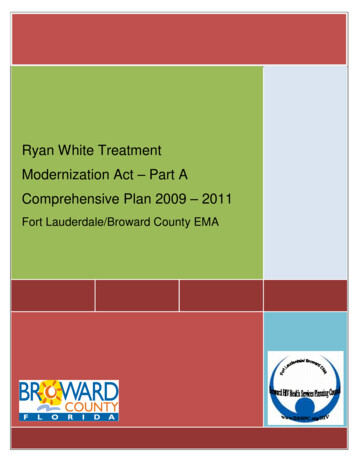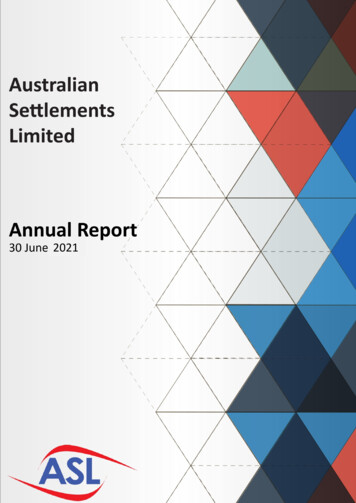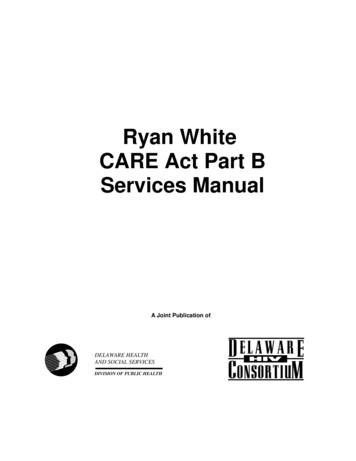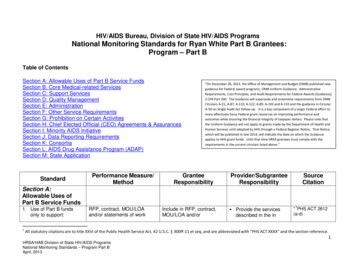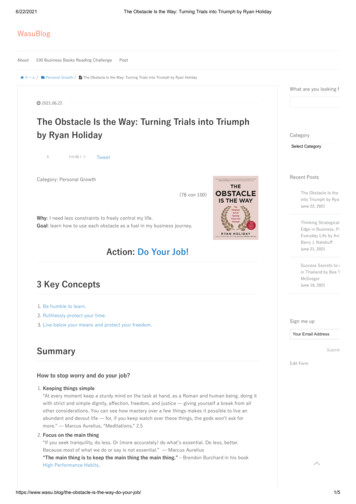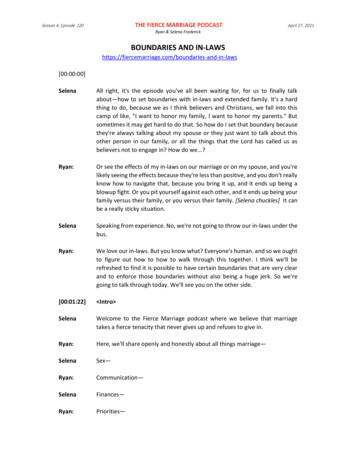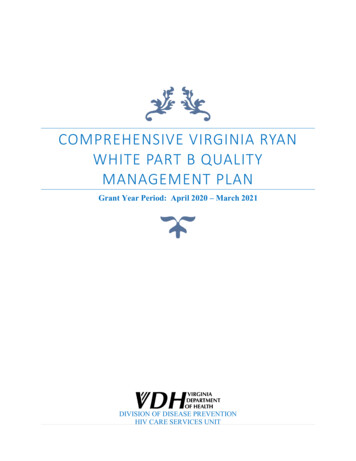
Transcription
COMPREHENSIVE VIRGINIA RYANWHITE PART B QUALITYMANAGEMENT PLANGrant Year Period: April 2020 – March 2021DIVISION OF DISEASE PREVENTIONHIV CARE SERVICES UNIT
Final: May 1, 2020Table of ContentsI.INTRODUCTION2II.AUTHORITY3III.VIRGINIA DEPARTMENT OF HEALTH3IV.QUALITY STATEMENT4V.DEFINITION OF QUALITY TERMINOLOGY5VI.QUALITY MANAGEMENT INFRASTRUCTURE6VII.QUALITY MANAGEMENT EXPECTATIONS OF SUBRECIPIENTS10VIII. 2020-2021 WORK PLAN GOALS AND IMPLEMENTATION11IX.PERFORMANCE MEASUREMENT12X.QUALITY IMPROVEMENT15XI.PARTICIPATION OF STAKEHOLDERS16XII.CAPACITY BUILDING16XIII. COMMUNICATION17IVX. EVALUATION OF QUALITY MANAGEMENT PROGRAM17APPENDIX A: GLOSSARY21APPENDIX B: QMAC COMMITTEE APPLICATION FORM22APPENDIX C: 2020 QUALITY MANAGEMENT PROGRAM SUBRECIPIENTREQUIREMENTS SUMMARY23APPENDIX D: QUALITY IMPROVEMENT PROJECT REPORTING TEMPLATE25APPENDIX E: IMPLEMENTATION OF HIV SERVICES WORK PLAN FY 20202021311APPENDIX E: IMPLEMENTATION OF HIV SERVICES WORK PLAN FY 2020202133APPENDIX E: IMPLEMENTATION OF HIV SERVICES WORK PLAN FY 2020202137APPENDIX F: GRANT YEAR 2020 SELECTED OUTCOME MEASURES GOALS FORRWHP B FUNDED SERVICES39APPENDIX G: HRSA HIV/AIDS BUREAU SERVICE CATEGORY48APPENDIX H: QMAC ORGANIZATIONAL CHART50APPENDIX I: VIRGINIA QUALITY MANAGEMENT PROGRAM FLOW CHART51i Page
Final: May 1, 2020Comprehensive Virginia Ryan White Part B Quality Management PlanGrant Year Period: April 1, 2020 – March 31, 2021I.INTRODUCTIONRyan White Human Immunodeficiency Virus/Acquired Immunodeficiency Syndrome(HIV/AIDS) Program Legislation requires the implementation of Clinical QualityManagement Programs (QMPs) as a condition of the Notice of Award, the elements ofwhich are delineated in the revised Policy Clarification Notice 15-02 1. The qualityManagement expectations for Ryan White HIV/AIDS Program (RWHP) Part B recipientsinclude: Assisting funded subrecipients in assuring that grant supported services adhere toestablished Department of Health and Human Services (HHS) Clinical Guidelinesto the greatest extent possible;Ensuring that strategies for improvements to quality medical care includes theappropriate access and retention to HIV care, support for treatment adherence andviral load suppression; andEnsuring that available data are collected and used to monitor the healthoutcomes.The Virginia Department of Health (VDH) is committed to improving the quality of careand services for people living with HIV (PLWH) through a comprehensive QMP thatinvolves continuous monitoring, Quality Improvement Projects (QIPs), capacity-buildingopportunities, and a performance measurement (PM) based program. The VDH QualityManagement Plan, which is to be shared with all stakeholders, frames the HIV CareServices (HCS) continuous quality improvement activities, describes the infrastructureand delineates the performance measures.This document is available in print and on the following tion/disease-prevention/hiv-care-services/The implementation of the content will be effective April 1, 2020. If you have anyquestions concerning this plan, please contact Safere Diawara, MPH, Clinical QualityManagement Coordinator at (804) 864-8021 or by email gement/clinicalqualitymanagementpcn.pdf2 Page
Final: May 1, 2020II.AUTHORITYIII.VIRGINIA DEPARTMENT OF HEALTHVDH’s Division of Disease Prevention (DDP) administers theRWHP Part B. DDP has four units including SexuallyTransmitted Disease (STD) Prevention & Surveillance, HIVSurveillance, HIV & Hepatitis Prevention (HHPS), and HIVCare Services (HCS).DDPThe Health Resources and Services Administration (HRSA) is an agency of the U.S.Health and Human Services (HHS) that serves the uninsured, isolated or medicallyvulnerable. Within HRSA, the HIV/AIDS Bureau (HAB)administers the RWHP, the largest federal program focusedHIV Care Servicesexclusively on HIV/AIDS care. The RWHP serves those whodo not have sufficient health care coverage or financialresources for coping with HIV disease.HIV SurveillanceHIV & HepatitisPreventionSTD Prevention &SurveillanceVDH provides core medical and support services for over 8,000 HIV/AIDS eligibleclients by funding subrecipients, as well as Minority AIDS Initiatives (MAI) and theEmerging Communities (EC) Initiatives. Funded agencies provide core and supportservices, collect client-level data, and implement Quality Management Plans and QIPs toensure provision of quality services.HCS provides leadership and support to the funded agencies and is dedicated to theprovision of education, information, and health care services that promote and protect thehealth of all Virginians. The HCS unit within DDP administers the QMP.The Virginia Medication Assistance Program (VA MAP) provides access to life-savingmedications for the treatment of HIV and related illnesses for low-income clients throughthe provision of medications or through assistance with insurance premiums andmedication copayments. VA MAP is primarily supported with federal RWHP Part Bgrant funding. VA MAP also receives support from state general funds. Other fundingsources include pharmaceuticals rebates and Medicaid reimbursements for clients whoreceive retroactive eligibility.The VA MAP provides insurance cost support or directly purchased medications throughthe following programs: Affordable Care Act (ACA) and Other Insurance: VA MAP pays premiums andmedication cost shares (copayments, coinsurance, and deductibles) for plans that meetfederal and state VA MAP criteria. VA MAP also supports medication cost sharesfor eligible clients who have other forms of private insurance meeting federal andstate VA MAP criteria under the Insurance Continuation Assistance Program (ICAP).3 Page
Final: May 1, 2020 IV.Medicare Part D Assistance Program: The Medicare Part D Assistance Program payspremiums and medication cost shares for VA MAP eligible clients enrolled inMedicare Part D that is supported by appropriated State Pharmaceutical AssistanceProgram (SPAP) funds.Direct MAP: Medications on the VA MAP formulary are purchased at discountedrates by the VDH Central Pharmacy and distributed through local health districts andother medication access sites for pickup by clients. Clients who are not eligible for orunable to enroll in other insurance such as the health marketplace, Medicaid orMedicare Part D may receive medications through Direct MAP.QUALITY STATEMENTA. Mission Statement:The RWHP Part B QMP exists to ensure the highest quality core medical care andsupportive services for PLWH in Virginia, as well as to provide medication access tothem through statewide leadership and stakeholder collaboration.B. Vision:VDH envisions optimal health and medication access for all PLWH, supported by ahealth care system that assures ready access to comprehensive, competent, andquality care.C. Values:VDH believes in creating HIV services that inspire and promote quality, parity, costeffectiveness, client centered, stakeholder input, and teamwork.D. Goals:The goals of the RWHP Part B QMP are to: Assess quality management needs and build capacity in quality within RWHPPart B funded agencies statewide;Improve data management practices and client satisfaction assessmentprocesses.; andEnhance the HIV service delivery system and its related health outcomes.E. Purpose:The aim of the RWHP Part B QMP is to continuously improve the quality of care andservices delivered, and to be compliant with recognized HHS Services ClinicalGuidelines, National Priorities, HRSA Monitoring and Service Standards, andresearch-based best practices. This will be accomplished by: Developing and implementing a statewide Quality Management Plan;Monitoring core selected performance measures across Ryan White recipientsand subrecipients;Providing training and technical assistance related to quality improvement;and4 Page
Final: May 1, 2020 V.Participating in statewide, cross-jurisdictional and national qualitymanagement collaborative projects.DEFINITION OF QUALITY TERM INOLOGYThe following definitions can be found on the TARGET Center website athttps://targethiv.org/cqii and additional acronym list can be found in the Glossary inAppendix A.A. Quality:Quality as defined by the HAB is the degree to which a health or social service meetsor exceeds established professional standards and user expectations. Evaluation ofthe quality of care should consider the quality of ideas, information and suggestions,the quality of the service delivery process, and the quality of life outcomes.B. Indicator:A measurable variable or characteristic that can be used to determine the degree ofadherence to a standard or the level of quality achieved.C. Performance Measure:A quantitative tool that provides an indication of the quality of a service or process.It is a number assigned to an object or event that quantifies the actual output andquality of work performed.D. Quality Management:A larger concept, encompassing continuous quality improvement activities and themanagement of systems that foster such activities: communication, education, andcommitment of resources. The integration of quality throughout the organization ofthe agency is referred to as Quality Management (QM). The QMP embraces qualityinfrastructure, performance measures and quality improvement functions.E. Quality Assurance:A broad spectrum of evaluation activities designed to ensure compliance withminimum quality standards. An ongoing monitoring of services for compliance withthe most recent Department of Human and Health Services Clinical Guidelines, andadherence to state and federal laws, rules, and regulations (Administrative duties).F. Quality Improvement:A description of the ongoing monitoring, evaluation, and improvement process. Itincludes a process that focuses on preventing problems and maximizing quality ofcare. This focus is a means for measuring improvement to access quality of HIVservices and better health outcomes.G. Plan, Do, Study, Act Cycles:The Plan, Do, Study, Act (PDSA) cycle methodology is a model for performanceimprovement used for all quality improvement activities:5 Page
Final: May 1, 2020 PLAN – Identify and analyze what you intend to improve, looking for areasthat hold opportunities for change.DO – Carry out the change or test on a small scale.STUDY – Complete analysis and synthesis, compare data to prediction inPLAN, and record under what conditions the results could be different.Summarize what was learned, identify if changes led to improvements in theway you had hoped and consider next steps.ACT – Adopt the change, abandon it, or initiate a new PDSA cycle.H. Outcomes:Results achieved by participants during or after their involvement with a program.Outcomes may relate to knowledge, skills, attitudes, values, behavior, conditions orhealth status.I. Outcome Indicator:An outcome indicator is the specific information that tracks program success orfailure towards meeting standards or projected outcomes. This definition is used todescribe observable, measurable characteristics or changes that represent the productof an outcome.VI.QUALITY MANAGEMENT INFRASTRUCTUREA. Oversight:Within DDP, the HCS unit implements the QMP. The Clinical Quality ManagementCoordinator provides general oversight of the QMP, coordinates program evaluationand quality management activities, oversees service standards and outcomemeasurement activities, analyzes outcomes data, and integrates the data into requestedreports. The Coordinator is also responsible for developing the Quality ManagementPlan, coordinating training on quality management topics, managing client recordreviews and providing technical assistance as appropriate. The Clinical QualityManagement Coordinator works in collaboration with the Quality ManagementAdvisory Committee (QMAC), the statewide cross-part collaborative.The Clinical Quality Management Coordinator is assisted by a Quality ManagementSpecialist who works to plan, organize and oversee funded agencies’ qualityimprovement activities and ensures that funded performance measures and qualityimprovement plan (QIP) initiatives are focused on improving program efficiencies.The Quality Management Specialist also participates in agency organizational qualitymanagement strategic planning and provides needed technical assistance.The quality activities are supported by an array of staff and supervisors throughoutDDP, with varying levels of authority and responsibilities.6 Page
Final: May 1, 2020B. Quality Management Committees:The Quality Management committee structure involves several groups, which aredescribed and depicted below and included in appendices E, H, and I.HCS QualityManagementADAP AdvisoryCommitteeQuality MgmtLeadership TeamHCS QualityImprovement TeamQuality ManagementAdvisory Committee(QMLT)(HCS QIT)(QMAC)Ad Hoc ProcessImprovement TeamsQuality Management Leadership Team (QMLT)The overarching quality management activities are overseen by HCS’s QMLT.Charged with providing leadership and oversight for all HCS led qualityimprovement activities. The QMLT ensures adequate resources are available to carryout the annual quality management work plan. The QMLT meets monthly.Membership of the QMLT consists of: Director of HCSAssistant Directors of HCSLead HIV Services CoordinatorHIV Care Services AnalystRyan White Fiscal Business ManagerClinical Quality Management CoordinatorQuality Management SpecialistHIV Care Services PlannerHIV Care Services Grant ManagerHCS Quality Improvement Team (QIT)Comprised of HCS leaders who meet through the HCS Leadership Weekly Meetings.The team monitors implementation of QIPs, reviews relevant performance measures,helps in planning for QMAC meetings, interfaces with QMAC and coordinates otherquality activities like trainings and Peer Review process. The team discussesimprovement ideas and addresses constructive feedback on improvement initiatives.The HCS QIT consists of: HIV Care Services CoordinatorsVA MAP Director and assigned staff7 Page
Final: May 1, 2020 VA MAP Data ManagerClinical Quality Management CoordinatorQuality Management SpecialistHIV Care Services Grants ManagerHIV Care Services PlannerAd Hoc Process Improvement TeamsTopic-driven QITs are convened on an ad hoc basis to implement processimprovement. Membership is dependent on the issue or process being addressed.The meeting frequency is determined based on the scope of the QIP. For each QIP, aQIP Memo will be established, which includes pertinent information, such as baselinedata, intended goal, performance measure and team membership. Updates onprogress will be routinely shared with the HCS QIT and will include performancedata and changes tested.QMACImplementing quality management across the state requires input, buy-in and supportfrom key stakeholders. The QMAC is established to provide a forum to solicit suchinput. Membership is comprised of over 40 members across the five health regionsincluding all RWHP (A, B, C, D, and F), data managers, physicians, AIDS Educationand Training Centers (AETC’s), program administrators and PLWH. The QMAC isresponsible for reviewing quality data to identify trends, developing priorities, andsetting quality improvement goals and measures. Additional responsibilities includereviewing and implementing elements of the Quality Management Plan and servicestandards, and developing strategies to improve care processes. Many members ofQMAC are also members of the Community HIV Planning Group. The QMACmeets on a quarterly basis to review system-wide quality management issues,challenges, and developing strategies to improve care.The QMAC has established an Executive Committee and five standingSubcommittees as described below: Executive Committee: Provides oversight and support to the QMAC andworks with QMAC members to set goals, determine priorities and providetechnical support necessary to implement identified quality initiatives.Virginia Quality of Care Consumer Advisory Subcommittee (VACAC):Ensures PLWH have input into the creation, development and implementationof VDH services, policies and quality activities.Data Subcommittee: Provides guidance on applying data to QIPs and qualitymanagement initiatives.Capacity Building Subcommittee: Supports the development of Ryan WhiteCross-Parts quality management activities by identifying training andtechnical assistance needs and strategies to address those needs.Communication Subcommittee: Serves as the official communication channelfor the QMAC and makes recommendations regarding quality improvementactivities.8 Page
Final: May 1, 2020 Quality Improvement Subcommittee: Guides the implementation of QIPs andassists with recommendations and best practices.Membership on the QMAC is reviewed annually and is open to all Ryan Whiteproviders and PLWH. Participating members who wish to serve on the QMAC mustcomplete the application form (Appendix B). The QMAC co-chairs review all newapplications and recommend selection to the Quality Management Coordinator.Additional information regarding the QMAC, subcommittee structure and key rolesand responsibilities is available through the companion document Virginia QMACOrientation Manual located at ase-prevention/hiv-care-services/ (under Quality ManagementProgram section).AIDS Drugs Assistance Program (ADAP) Advisory CommitteeA separate ADAP Advisory Committee is established that is comprised of HIV/AIDSmedical providers, a pharmacist, consumers, and local health districts’ representation.The committee advises VDH on VA MAP programmatic, clinical, educational issuesand formulary changes, with particular emphasis on the following:1. Ensuring necessary therapeutics are made available and set up mechanisms tosupport treatment adherence;9 Page
Final: May 1, 20202. Clearly defining how the VA MAP formulary is determined and how itchanges over time as new pharmacological knowledge emerges; and3. Assessing how quickly the VA MAP program adjusts its formulary as newtreatment advances are made, as well as, how quickly new antiretroviralmedications are approved as new pharmacological knowledge emerges.C. Peer Review Team:A formal Peer Review process is established to assess the quality of services renderedby RWHP Part B service providers. The Peer Review Team, comprised of a team ofmedical providers, case managers and consumers, collects performance measure data,reviews client charts and selected QIP data and provides technical assistance. PLWHteam members conduct consumer peer-to-peer interviews designed to explore qualityof care and satisfaction from the client perspective. The Virginia CommonwealthUniversity HIV/AIDS Resource Center coordinates the Peer Review Team activities.Subrecipients receiving RWHP Part B funding are reviewed on a biennial schedule.D. Dedicated Resources:Key resources include the following: VII.HRSA/HAB Quality Management Manual:http://hab.hrsa.gov/affordablecareact/The Center for Quality Improvement and Innovation of the New York StateDepartment of eral/about/quality.htmRyan White TARGET Center /clinical-quality-managementThe Local Performance Sites of the Mid-Atlantic AIDS Education andTraining Center: www.pamaaetc.orgNorthern, Eastern and Central/Southwest Virginia HIV/AIDS ResourceConsultation Centers: www.vharcc.comVA MAP: map/Quality management information can be found /disease-prevention/hiv-careservices/Glasscubes: www.glasscubes.comQUALITY MANAGEMENT EXPECTATIONS OF SUBREC IPIENTSThe following quality management requirements are delineated in subrecipients’contractual agreement documents (Appendix C):1. Each subrecipient must develop, update and submit an annual Ryan White QualityManagement Plan as indicated in the subrecipient’s contract deliverables. Theplan must include:10 P a g e
Final: May 1, 2020a. Quality Statement (Brief purpose describing the end goal of the HIVQuality Program);b. Quality Infrastructure (Leadership, quality committees, roles andresponsibilities, and resources);c. Performance Measurement (Identifies indicators, who is accountable,how to report and disseminate. Identifies a process in place to use data todevelop quality improvement activities);d. Annual Quality Goals (Select only a few measurable and realistic goalsannually and establish thresholds at the beginning of the contract year foreach goal);e. Participation of Stakeholders (Lists internal and external stakeholdersand specify their engagement in the QMP, includes communityrepresentatives and partners, and specifies how feedback is gathered fromkey stakeholders); andf. Evaluation (Evaluates the effectiveness of the quality management/quality improvement infrastructure to decide whether to adjust howquality improvement work is done and review performance measures andQIPs).The Clinical Quality Management Coordinator and the Quality ManagementSpecialist, in collaboration with the HIV Services Coordinators, review progress onQuality Management Plans and QIPs. Feedback is provided in monthly report andquarterly QIP report responses.2. Subrecipient shall complete a program-specific QIP annually based on theselected QIP. In 2020, the QIP is focused on enhancing the viral load suppressionrate – with efforts focused solely on those non-virally suppressed. Progress of theQIP will be reported on a quarterly basis by using a VDH recommended QIPsummary template (Appendix D). All sites are encouraged to undertakeadditional QIPs, if needed, that focus on issues specific to their program.3. Subrecipients shall participate in statewide quality management activities(meetings, trainings, improvement projects and data/report submission requests),to include at least three (3) QMAC meetings and the annual Quality Managementand Case Management Summits.VIII. 2020-2021 WORK PLAN GOALS AND IMPLEMENTATIONThe work plan activities are monitored at least quarterly by the Clinical QualityManagement Coordinator and the Quality Management Specialist and reviewed with theQMAC Executive Committee. Updates and progress are shared at the QMAC quarterlymeetings with discussion and suggestions elicited. The full implementation work plan isfound in Appendix E. The quality management goals include:Goal A. Developing and implementing the 2020-2021 RWHP Part B QualityManagement Plan.11 P a g e
Final: May 1, 2020Goal B. Strengthening the existing Virginia Ryan White Cross-Parts infrastructure tosupport quality improvement activities in Virginia.Goal C. Ensuring that health-related core and support services including MAP,provided by VDH and funded agencies improve the HIV continuum of carestatus.Goal D. Providing technical assistance and quality trainings on an ongoing basis.Goal E. Strengthening internal RWHP Part B Grantee quality improvementinitiatives.IX.PERFORMANCE MEASUREMENTThe RWHP B collects and analyzes performance measurement data to identify andprioritize QIPs, routinely monitors the quality of care provided to PLWH, and evaluatesthe impact of changes made to improve the quality and systems of HIV care.A. Selected Measures for Ryan White Part B:Specific clinical and prevention indicators to be measured for all Ryan White Part Bfunded services include:Indicator to beMeasuredMeasurementOutcomeData Elements used to MeasureIndicatorLinkage to HIVMedical CarePercentage ofpersons whoattended a HIVmedical careservices and had acare marker within30 days of HIVdiagnosisNumerator:Number of persons who attended a HIVmedical care services and had a caremarker within 30 days of HIV diagnosisRetention inHIV MedicalCarePercentage ofpersons with an HIVdiagnosis who arereceiving HIVmedical careservices who hadtwo care markers inthe 12-monthmeasurement periodDenominator:Number of persons with an HIVdiagnosis in the 12-month measurementperiodNumerator:Number of people enrolled in RWHPPart B-funded program living with HIVand receiving HIV medical care serviceswho had at least two care markers in 12month measurement period that are atleast 3 months apartDenominator:Number of people enrolled in RWHPPart B-funded program living with HIVand receiving HIV medical care serviceswho had at least one care marker inthe12-month measurement period12 P a g e
Final: May 1, 2020AntiretroviralTherapy AmongPersons in HIVMedical CareViral LoadSuppressionAmong Personsin HIV MedicalCarePercentage ofpersons with an HIVdiagnosis who areprescribedAntiretroviraltherapy in the 12month measurementperiodPercentage ofpersons with an HIVdiagnosis with aviral load 200copies/mL at last testin the 12–monthmeasurement periodNumerator:Number of persons with an HIVdiagnosis who are prescribedAntiretroviral therapy in the 12-monthmeasurement periodDenominator:Number of persons with an HIVdiagnosis and who had at least one HIVmedical care service in the 12-monthmeasurement periodNumerator: Number of persons with anHIV diagnosis with a viral load 200copies/mL at last test in the 12–monthmeasurement periodDenominator:Number of persons with an HIVdiagnosis and who had at least one HIVmedical care service in the 12-monthmeasurement periodVirginia RWHP Part B has selected HIV continuum of care (HCC) relatedperformance measures for each funded service including VA MAP, which includemonitoring care markers (CD4 test dates, viral load test dates, antiretroviral therapyprescription dates, and HIV medical care visit dates). HCC performance measuresapply to all funded services, excluding Oral Health Care and Early InterventionServices (EIS).The exception for Oral Health Care and EIS Outreach/Education funded services,which will be measured as below:Oral Health CareIndicator to be MeasuredPercentage of persons withan HIV diagnosis who arereceiving Oral Healtheducation session in the 12month measurement periodNumerator:Denominator:Number of people enrolled inRWHP Part B living with HIVand receiving oral Healtheducation session at least onceduring the 12-mo periodEIS Health EducationIndicator to be MeasuredPercentage of peopleenrolled EIS who havedocumentation of educationgiven regarding HIV diseaseprocess, risk reduction, andNumerator:Number of peopleenrolled in RWHP PartB-funded programliving with HIV andreceiving Oral HealthCare services,regardless of age.Denominator:Number of people enrolled inRWHP Part B living with HIVand receiving EIS who havedocumentation of educationNumber of peopleenrolled in RWHP PartB-funded programliving with HIV and13 P a g e
Final: May 1, 2020maintenance of the immunesystem in the 12-monthmeasurement periodgiven regarding HIV diseaseprocess, risk reduction, andmaintenance of the immunesystem in the 12-monthmeasurement periodreceiving EIS services,regardless of age in the12-month measurementperiodB. Data Collection:Subrecipients utilize the following methods and databases for data collection: clientinterviews, chart reviews, and selected/procured VDH statewide data system. Inaddition, VDH maintains a database specifically for VA MAP eligibility and serviceinformation. Overall collected data include: Client eligibility and recertification dataUtilization patterns dataHIV continuum of care dataClient Satisfaction dataNeeds assessment dataOther data as required and/or deemed necessaryC. Data Sources:The Virginia QMP is responsible for regular analysis and reporting of qualitymanagement data that include but is not limited to: Client satisfaction surveys/interviewsHIV continuum of care dataVA MAP dataStatewide Coordinated Statement of NeedEnhanced HIV/AIDS Reporting System dataUnmet Needs data referring to the population that is out of careVDH collaborates with all Ryan White Part A, B, C, D and F providers in theCommonwealth to provide client-level data on a monthly basis. Providers that utilizeCAREWare directly self-import data into selected/procured VDH statewide datasystem.D. Reporting Mechanisms of Quality Management Activity Data:Compiled data findings from several sources are shared in an aggregated format withHIV providers, VDH leadership, and other stakeholders. Data is pulled from the fulllist of clients served by each subrecipient, with the previous method assigning a clientto a specific subrecipient based on the client’s most recent service date. Thisprovides a more accurate picture of the subrecipient’s client base outcomes. Reportshighlighting the subrecipient’s client outcomes show visual comparison of outcomescompared to the outcomes of all quality management subrecipients pooled togetherfor the preceding three years prior to the reporting period. These specific data reports14 P a g e
Final: May 1, 2020also show the visual and temporal change in outcomes for the preceding three yearsprior to the reporting period for the specific subrecipient clients.VDH collects and analyzes HCC data to inform the monitoring of HIV care, identifytrends in HIV-related health outcomes over time and across jurisdictions, clinics andprograms, and determine programmatic needs by analyzing gaps and healthdisparities. VDH solicits feedback through Quality Management committees andsubrecipients in planning, implementing, and evaluating quality of care programactivities to be responsive to the changes in clinical and scientific knowledge.Recommendations for action step are made to address identified needs and servicegaps. Some may be addressed through the services that are supported in the statewideQuality Management Plan while others provide a vision for longer-term strategies ofideal system of care.Several types of qualitative and quantitative data give VDH and its partner’sinformation on the selected performance measures and help them shape improvementgoals and projects. For example, a Data to Care approach has been used to ide
services, collect client-level data, and implement Quality Management Plans and QIPs to ensure provision of quality services. HCS provides leadership and support to the funded agencies and is dedicated to the provision of education, information, and health care servic


